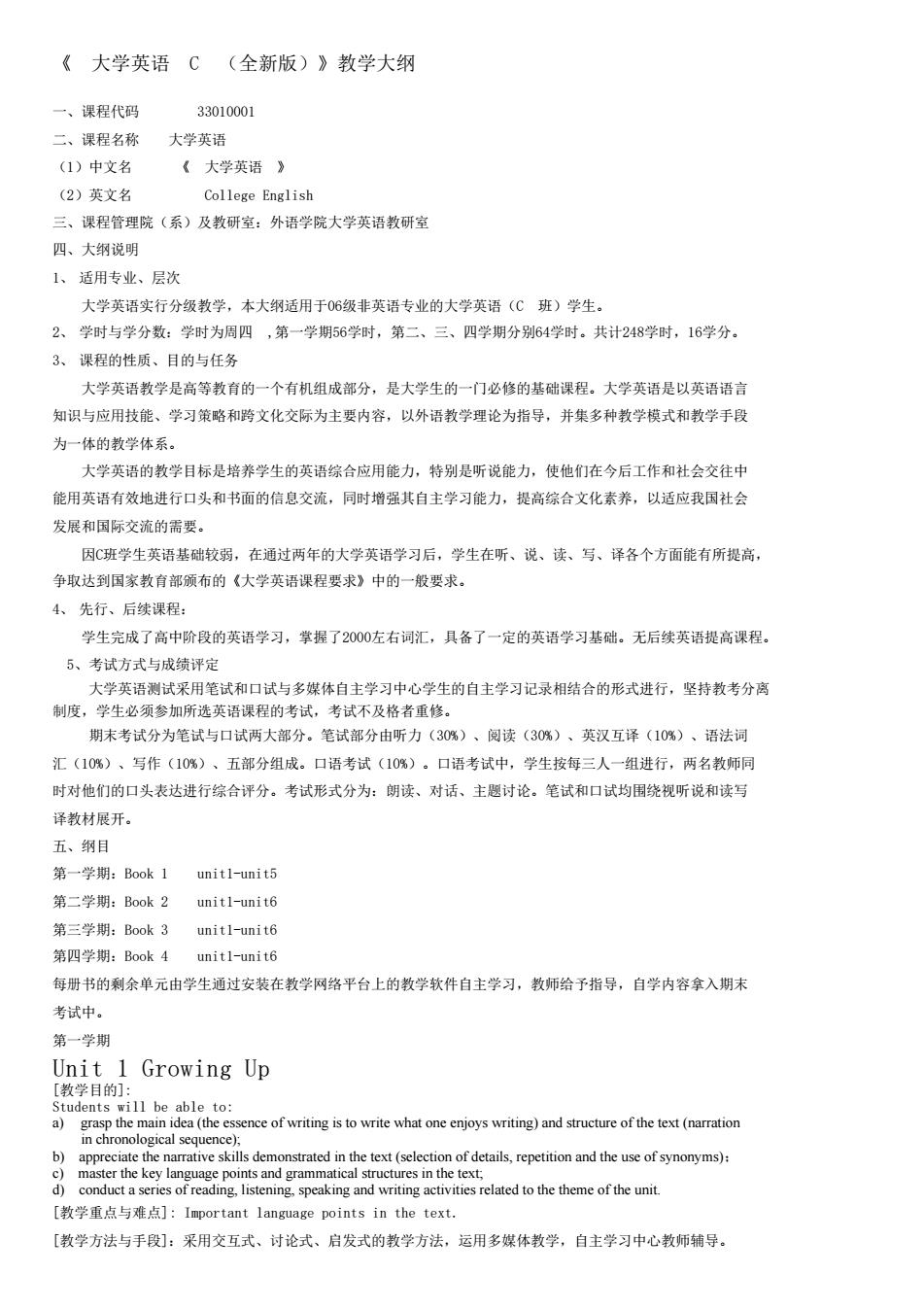
《大学英语C(全新版)》教学大纲 一、课程代码 33010001 二、课程名称 大学英语 (1)中文名 《大学英语》 (2)英文名 College English 三、课程管理院(系)及教研室:外语学院大学英语教研室 四、大纲说明 1、适用专业、层次 大学英语实行分级教学,本大纲适用于06级非英语专业的大学英诺(C班)学生 2、学时与学分数:学时为周四,第一学期56学时,第二、三、四学期分别64学时.共计248学时,16学分. 3、课程的性质、目的与任务 大学英语教学是高等教有的一个有机组成部分,是大学生的一一门必修的基础课程。大学英语是以英语语言 知识与应用技能、学习策略和跨文化交际为主要内容,以外语教学理论为指导,并集多种教学模式和教学手段 为一体的教学体系。 大学英语的教学目标是培养学生的英语综合应用能力,特别是听说能力,使他们在今后工作和社会交往中 能用英语有效地进行口头和书面的信息交流,同时增强其自主学习能力,提高综合文化素养,以适应我因社会 发展和国际交流的需要。 因C班学生英语基础较弱,在通过两年的大学英语学习后,学生在听、说、读、写、译各个方面能有所提高 争取达到国家教有部颁布的《大学英语课程要求》中的一般要求, 4、先行、后续课程: 学生完成了高中阶段的英语学习.掌提了2000左右词汇,具各了一定的英语学习基础。无后续英语提高课程。 5、考试方式与成绩评定 大学英语测试采用笔试和口试与多媒体自主学习中心学生的自主学习记录相结合的形式进行,坚持教考分高 制度,学生必须参加所选英语课程的考试,考试不及格者重修, 期末考试分为笔试与口试两大部分。笔试部分由听力(30%)、阅读(30%)、英汉互译(10%)、语法词 汇(10%)、写作(10%)、五部分组成。口语考试(10%)。口语考试中,学生按每三人一组进行,两名教师同 时对他们的口头表达进行综合评分。考试形式分为:朗读、对话、主题讨论。笔试和口试均围绕视听说和读写 译教材展开。 五、纲目 第一学期:Book1 unitl-unit 第二学期:Book2 unitl-unit6 第三学期:B0ok3 unitl-unit6 第四学期:Book4 unitl-unit6 每册书的剩余单元由学生通过安装在教学网络平台上的教学软件自主学习,教师给予指导,自学内容拿入期未 考试中。 第一学期 Unit 1 Growing Up [教学目的] ssence of writing is to write what one enjoys writing)and structure of the text(nation related to the theme of the unit [教学重点与难点]:Important language points in the text. [教学方法与手段]:采用交互式、讨论式、启发式的教学方法,运用多媒体教学,自主学习中心教师辅导
《 大学英语 C (全新版)》教学大纲 一、课程代码 33010001 二、课程名称 大学英语 (1)中文名 《 大学英语 》 (2)英文名 College English 三、课程管理院(系)及教研室:外语学院大学英语教研室 四、大纲说明 1、 适用专业、层次 大学英语实行分级教学,本大纲适用于06级非英语专业的大学英语(C 班)学生。 2、 学时与学分数:学时为周四 ,第一学期56学时,第二、三、四学期分别64学时。共计248学时,16学分。 3、 课程的性质、目的与任务 大学英语教学是高等教育的一个有机组成部分,是大学生的一门必修的基础课程。大学英语是以英语语言 知识与应用技能、学习策略和跨文化交际为主要内容,以外语教学理论为指导,并集多种教学模式和教学手段 为一体的教学体系。 大学英语的教学目标是培养学生的英语综合应用能力,特别是听说能力,使他们在今后工作和社会交往中 能用英语有效地进行口头和书面的信息交流,同时增强其自主学习能力,提高综合文化素养,以适应我国社会 发展和国际交流的需要。 因C班学生英语基础较弱,在通过两年的大学英语学习后,学生在听、说、读、写、译各个方面能有所提高, 争取达到国家教育部颁布的《大学英语课程要求》中的一般要求。 4、 先行、后续课程: 学生完成了高中阶段的英语学习,掌握了2000左右词汇,具备了一定的英语学习基础。无后续英语提高课程。 5、考试方式与成绩评定 大学英语测试采用笔试和口试与多媒体自主学习中心学生的自主学习记录相结合的形式进行,坚持教考分离 制度,学生必须参加所选英语课程的考试,考试不及格者重修。 期末考试分为笔试与口试两大部分。笔试部分由听力(30%)、阅读(30%)、英汉互译(10%)、语法词 汇(10%)、写作(10%)、五部分组成。口语考试(10%)。口语考试中,学生按每三人一组进行,两名教师同 时对他们的口头表达进行综合评分。考试形式分为:朗读、对话、主题讨论。笔试和口试均围绕视听说和读写 译教材展开。 五、纲目 第一学期:Book 1 unit1-unit5 第二学期:Book 2 unit1-unit6 第三学期:Book 3 unit1-unit6 第四学期:Book 4 unit1-unit6 每册书的剩余单元由学生通过安装在教学网络平台上的教学软件自主学习,教师给予指导,自学内容拿入期末 考试中。 第一学期 Unit 1 Growing Up [教学目的]: Students will be able to: a) grasp the main idea (the essence of writing is to write what one enjoys writing) and structure of the text (narration in chronological sequence); b) appreciate the narrative skills demonstrated in the text (selection of details, repetition and the use of synonyms); c) master the key language points and grammatical structures in the text; d) conduct a series of reading, listening, speaking and writing activities related to the theme of the unit. [教学重点与难点]: Important language points in the text. [教学方法与手段]:采用交互式、讨论式、启发式的教学方法,运用多媒体教学,自主学习中心教师辅导
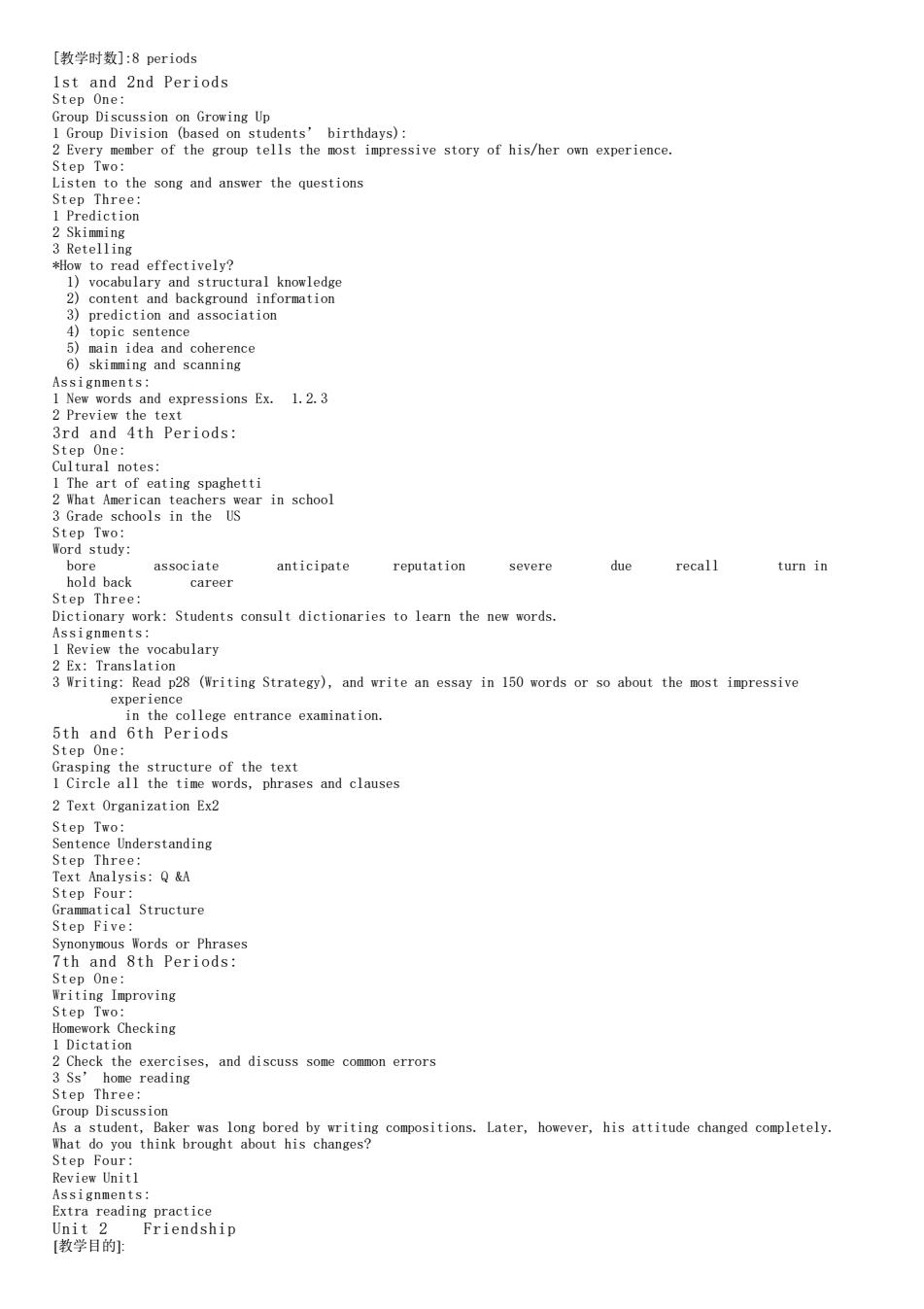
[教学时数]:8 periods 巴 impressive story of his/her own experience iefectivolye 2PeviorthadepresiomsE-23 3rd and 4th Periods: back associate anticipate reputation severe due recall turn in Step Three ork:Students consult dictionaries to learn the new words ocabulary p28(riting Strategy),and write an essay in 150 words or so about the most impressive 5and6th"pePl8etranceeaminatiomn Text Analysis:QA k Checking Later,however,his attitude changed completely Review Unitl practice Friendship
[教学时数]:8 periods 1st and 2nd Periods Step One: Group Discussion on Growing Up 1 Group Division (based on students’ birthdays): 2 Every member of the group tells the most impressive story of his/her own experience. Step Two: Listen to the song and answer the questions Step Three: 1 Prediction 2 Skimming 3 Retelling *How to read effectively? 1) vocabulary and structural knowledge 2) content and background information 3) prediction and association 4) topic sentence 5) main idea and coherence 6) skimming and scanning Assignments: 1 New words and expressions Ex. 1.2.3 2 Preview the text 3rd and 4th Periods: Step One: Cultural notes: 1 The art of eating spaghetti 2 What American teachers wear in school 3 Grade schools in the US Step Two: Word study: bore associate anticipate reputation severe due recall turn in hold back career Step Three: Dictionary work: Students consult dictionaries to learn the new words. Assignments: 1 Review the vocabulary 2 Ex: Translation 3 Writing: Read p28 (Writing Strategy), and write an essay in 150 words or so about the most impressive experience in the college entrance examination. 5th and 6th Periods Step One: Grasping the structure of the text 1 Circle all the time words, phrases and clauses 2 Text Organization Ex2 Step Two: Sentence Understanding Step Three: Text Analysis: Q &A Step Four: Grammatical Structure Step Five: Synonymous Words or Phrases 7th and 8th Periods: Step One: Writing Improving Step Two: Homework Checking 1 Dictation 2 Check the exercises, and discuss some common errors 3 Ss’ home reading Step Three: Group Discussion As a student, Baker was long bored by writing compositions. Later, however, his attitude changed completely. What do you think brought about his changes? Step Four: Review Unit1 Assignments: Extra reading practice Unit 2 Friendship [教学目的]:
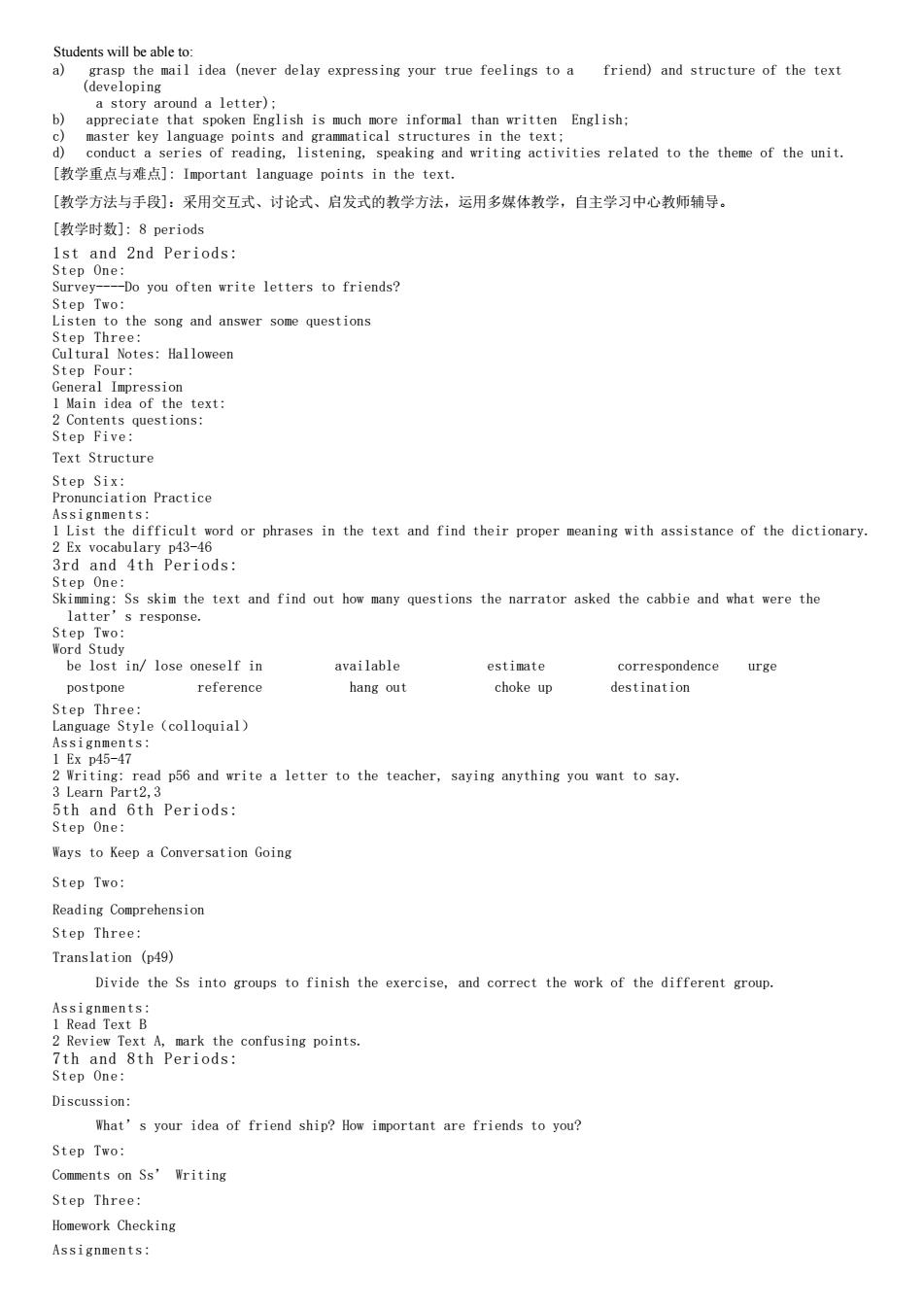
ide (nver delay epresin your t reeling ren)and tre of thetex stoping round a letter) 「教学重点与难点 eries of reading,listening.speaking and riting activities related to the theme of the uit Irportant language points in the text. [教学方法与手段]:采用交互式、讨论式、启发式的教学方法,运用多煤体教学,自主学习中心教师辅导。 [教学时数]:8 periods on2nd Periods pgnotos:hloen Text Structure Step Six: ard and 4th periods: Skiaing Ss skim the text and find out how any questions the narrator asked the cabbie and hat were the be lost in/lose oneself in available estimate correspondence urge postpone reference hang out choke up destination 西o品 thnd6th Periods: Ways to Keep a Conversation Going Step Two: Reading Comprehension Step Three: Translation (p49) Divide the Ss into groups to finish the exercise,and correct the ork of the different group fthamdT8thpeiodeonusingPoints Step One: Discussion: What's your idea of friend ship?How important are friends to you? Step Two Coments on Ss'Writing Step Three: Homework Checking Assignments
Students will be able to: a) grasp the mail idea (never delay expressing your true feelings to a friend) and structure of the text (developing a story around a letter); b) appreciate that spoken English is much more informal than written English; c) master key language points and grammatical structures in the text; d) conduct a series of reading, listening, speaking and writing activities related to the theme of the unit. [教学重点与难点]: Important language points in the text. [教学方法与手段]:采用交互式、讨论式、启发式的教学方法,运用多媒体教学,自主学习中心教师辅导。 [教学时数]: 8 periods 1st and 2nd Periods: Step One: Survey-Do you often write letters to friends? Step Two: Listen to the song and answer some questions Step Three: Cultural Notes: Halloween Step Four: General Impression 1 Main idea of the text: 2 Contents questions: Step Five: Text Structure Step Six: Pronunciation Practice Assignments: 1 List the difficult word or phrases in the text and find their proper meaning with assistance of the dictionary. 2 Ex vocabulary p43-46 3rd and 4th Periods: Step One: Skimming: Ss skim the text and find out how many questions the narrator asked the cabbie and what were the latter’s response. Step Two: Word Study be lost in/ lose oneself in available estimate correspondence urge postpone reference hang out choke up destination Step Three: Language Style(colloquial) Assignments: 1 Ex p45-47 2 Writing: read p56 and write a letter to the teacher, saying anything you want to say. 3 Learn Part2,3 5th and 6th Periods: Step One: Ways to Keep a Conversation Going Step Two: Reading Comprehension Step Three: Translation (p49) Divide the Ss into groups to finish the exercise, and correct the work of the different group. Assignments: 1 Read Text B 2 Review Text A, mark the confusing points. 7th and 8th Periods: Step One: Discussion: What’s your idea of friend ship? How important are friends to you? Step Two: Comments on Ss’ Writing Step Three: Homework Checking Assignments:
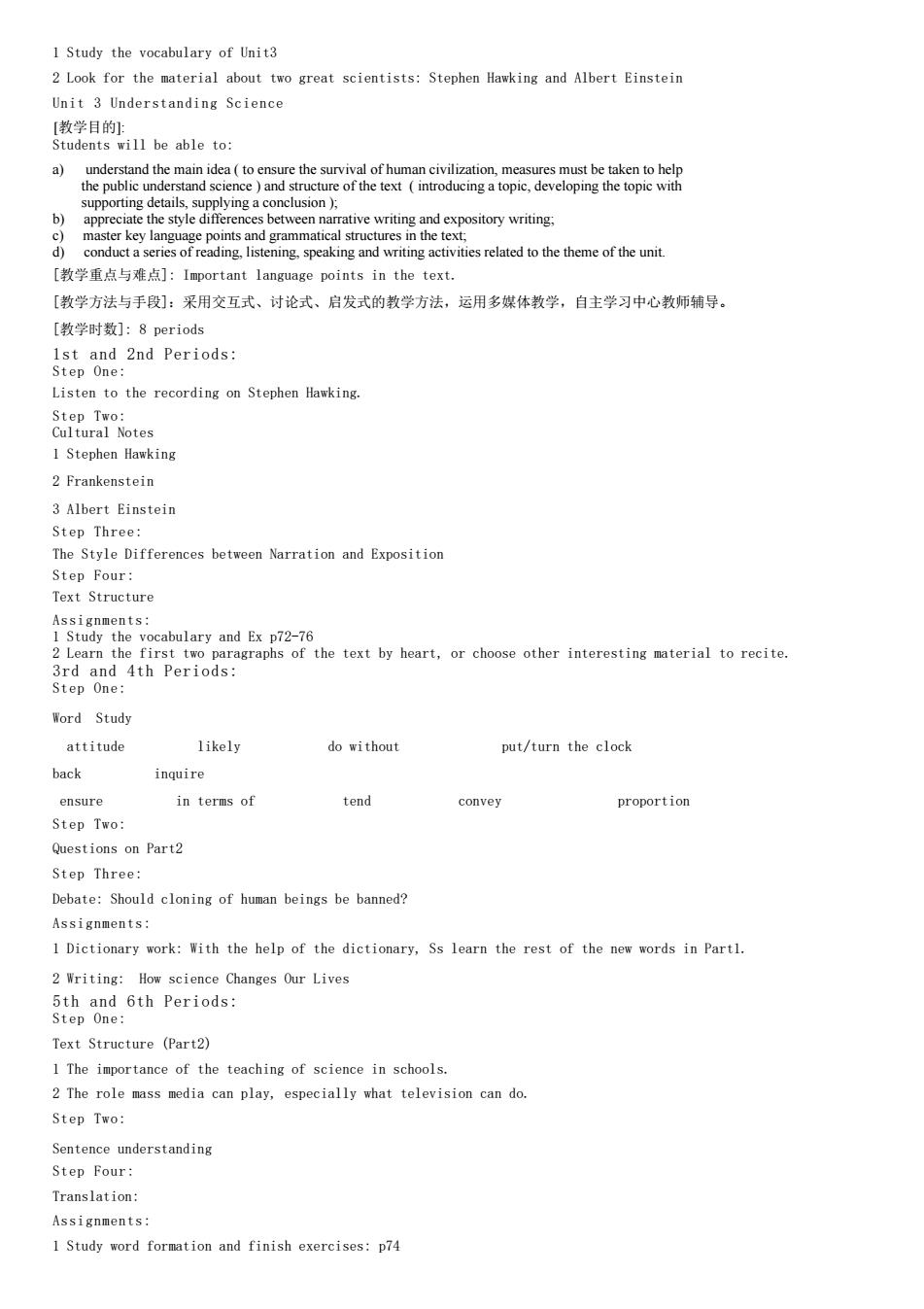
1 Study the vocabulary of Unit3 2 Look for the material about two great scientists:Stephen Hawking and Albert Einstein Unit 3 Understanding Science master key lansu ository writing. conduct a series o [教学重点与难点]:Important language points in the text. [教学方法与手段]:采用交互式、讨论式、启发式的教学方法,运用多煤体教学,自主学习中心教师辅导 [教学时数]:8 periods Ist and 2nd Periods Listen to the recording on Stephen Hawking. I Stephen Hawking 2 Frankenstein 3 Albert Einstein Step Three: The Style Differences between Narration and Exposition Step Four: Text Structure hragrahs o the text by heart.or choose other interestin mterial to reite rn 3rd a Step One: Word Study attitude likely do without put/turn the clock back inquire ensure in terms of tend convey proportion Sten Two Questions on Part2 Step Three: Debate:Should cloning of hunan beings be banned? Assignments: 1 Dictionary work:With the help of the dictionary.Ss learn the rest of the new words in Partl 2 Vriting:How science Changes Our Lives 5th and 6th Periods: Step One Text Structure (Part2) 1 The importance of the teaching of science in schools 2 The role mass media can play,especially what television can do Step Two Sentence understanding Step Four: Translation Assignments: 1 Study word formation and finish exercises:p74
1 Study the vocabulary of Unit3 2 Look for the material about two great scientists: Stephen Hawking and Albert Einstein Unit 3 Understanding Science [教学目的]: Students will be able to: a) understand the main idea ( to ensure the survival of human civilization, measures must be taken to help the public understand science ) and structure of the text ( introducing a topic, developing the topic with supporting details, supplying a conclusion ); b) appreciate the style differences between narrative writing and expository writing; c) master key language points and grammatical structures in the text; d) conduct a series of reading, listening, speaking and writing activities related to the theme of the unit. [教学重点与难点]: Important language points in the text. [教学方法与手段]:采用交互式、讨论式、启发式的教学方法,运用多媒体教学,自主学习中心教师辅导。 [教学时数]: 8 periods 1st and 2nd Periods: Step One: Listen to the recording on Stephen Hawking. Step Two: Cultural Notes 1 Stephen Hawking 2 Frankenstein 3 Albert Einstein Step Three: The Style Differences between Narration and Exposition Step Four: Text Structure Assignments: 1 Study the vocabulary and Ex p72-76 2 Learn the first two paragraphs of the text by heart, or choose other interesting material to recite. 3rd and 4th Periods: Step One: Word Study attitude likely do without put/turn the clock back inquire ensure in terms of tend convey proportion Step Two: Questions on Part2 Step Three: Debate: Should cloning of human beings be banned? Assignments: 1 Dictionary work: With the help of the dictionary, Ss learn the rest of the new words in Part1. 2 Writing: How science Changes Our Lives 5th and 6th Periods: Step One: Text Structure (Part2) 1 The importance of the teaching of science in schools. 2 The role mass media can play, especially what television can do. Step Two: Sentence understanding Step Four: Translation: Assignments: 1 Study word formation and finish exercises: p74
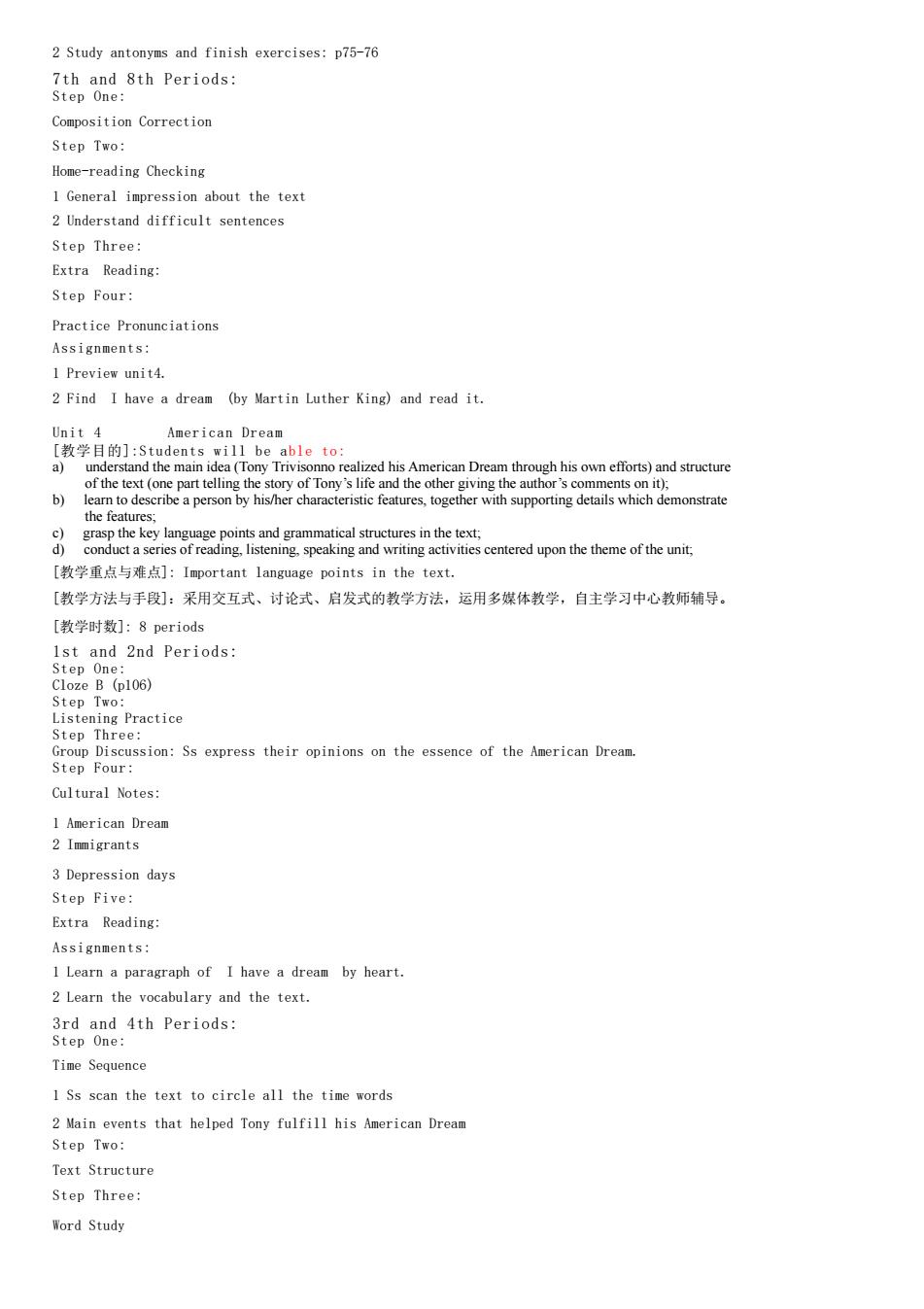
2 Study antonyms and finish exercises:p75-76 7th and 8th Periods: Step One Composition Correction Step Two: Home-reading Checking 1General impression about the text 2 Understand difficult sentences Step Three: Extra Reading: Step Four: Practice Pronunciations Assignments: 1 Preview unit4. 2 Find I have a dream (by Martin Luther King)and read it. 目的]:St American Dream d the main fthe te arealkhicocnpmehrnehhsomnctiRandsnctc [教学重点与难点]:I portant anguage points in the e text. the theme of thet [教学方法与手段]:采用交互式、讨论式、启发式的教学方法,运用多煤体教学,自主学习中心教师辅导。 [教学时数]:8 periods Step Two 106) Step Four: ssion:Ss express their opinions on the essence of the American Dreas Cultural Notes: 1 American Dream 2 Inmigrants 3 Depression days Step Five: Extra Reading: Assignments: 1 Learn a paragraph of I have a dream by heart 2 Learn the vocabulary and the text. 3rd and 4th Periods: Step One Time Sequence 1 Ss scan the text to circle all the time words 2 Main events that helped Tony fulfill his American Dream Step Two: Text Structure Step Three: Word Study
2 Study antonyms and finish exercises: p75-76 7th and 8th Periods: Step One: Composition Correction Step Two: Home-reading Checking 1 General impression about the text 2 Understand difficult sentences Step Three: Extra Reading: Step Four: Practice Pronunciations Assignments: 1 Preview unit4. 2 Find I have a dream (by Martin Luther King) and read it. Unit 4 American Dream [教学目的]:Students will be able to: a) understand the main idea (Tony Trivisonno realized his American Dream through his own efforts) and structure of the text (one part telling the story of Tony’s life and the other giving the author’s comments on it); b) learn to describe a person by his/her characteristic features, together with supporting details which demonstrate the features; c) grasp the key language points and grammatical structures in the text; d) conduct a series of reading, listening, speaking and writing activities centered upon the theme of the unit; [教学重点与难点]: Important language points in the text. [教学方法与手段]:采用交互式、讨论式、启发式的教学方法,运用多媒体教学,自主学习中心教师辅导。 [教学时数]: 8 periods 1st and 2nd Periods: Step One: Cloze B (p106) Step Two: Listening Practice Step Three: Group Discussion: Ss express their opinions on the essence of the American Dream. Step Four: Cultural Notes: 1 American Dream 2 Immigrants 3 Depression days Step Five: Extra Reading: Assignments: 1 Learn a paragraph of I have a dream by heart. 2 Learn the vocabulary and the text. 3rd and 4th Periods: Step One: Time Sequence 1 Ss scan the text to circle all the time words 2 Main events that helped Tony fulfill his American Dream Step Two: Text Structure Step Three: Word Study